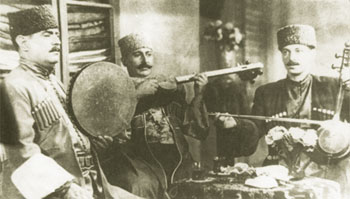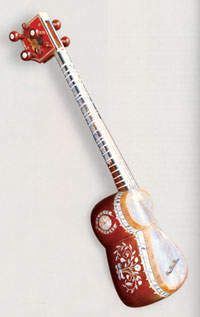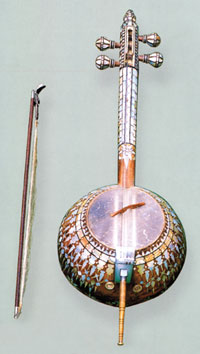 Pages 64-65
Pages 64-65by Jeffrey Werbock
The word mugham is used to designate a specialized style of music attributed to the Azerbaijani people of the Caucasus mountain range and nearby territories by that name. Mugham is generally recognized as a derivative of another specialised style of music attributed to the Persians, known there as dastgah. In the Caucasus, the refined music of the Persian court received a jolt of musical energy from the grand ancient tradition of the ashikh, the singing bard / minstrel of the mountains of Kavkaz. The full throated yodeling technique of the Kavkaz Azerbaijani ashikh lends an extraordinary power to the elegant and folksy melodies they employ while accompanying themselves on the saz, a long neck lute. When these two great and ancient musical traditions met and mixed, they gave birth to an extraordinary style of music that is evolving to this day.
To best appreciate mugham, it should be understood as a modern development of an ancient practice, which is the use of sound to induce a transformation of consciousness. Today this might be called trance music, but it would not be a good translation, because the word ’trance’ is associated with the hypnotic trance, whereas mugham offers an enhancement of consciousness, not a loss of consciousness of any degree.
Melodies used to attain ’trance’ states are relatively simple and repetitive, and versions of this can be found throughout the Middle East, Africa and Central Asia among the more nomadic tribes. In the cities, the more ’classical’ styles of music evolved, such as dastgah and mugham. In this sense, mugham is modern. It is as evolved in its form as the great classics of European music are in their form.
The evolution of mugham is in the incremental advancement of the density and subtlety of the construction of the melodic line. Free meter and microtonal, with the octave divided up into 84 potential divisions, mugham is guided by ’rules’ that allow for its perpetual renewal and further evolution in nuance. As ’trance’ music, the melodies composing mugham must remain true to the chosen scale, and the progression of tones must follow the natural contours of ripples on a wind blown lake. The melody must never jump round. There is nothing arbitrary about the way the principles of mugham shape a given melody. It must follow the sequence of the scale, proceeding up and down the tones of the chosen scale, one note closely following the other in pitch. At the same time, the order of the sequence is unexpected, and this unexpected order is repeated, like a fractal, down to the "atom" of music, the moment the note is actually played. There are four distinct features of mugham that the new listener may wish to be informed about. Because there are no real chordal structures in mugham, only melodies, the scales of mugham can be as microtonal as one might wish. This means that instead of dividing up the octave into seven whole intervals (or 12 half intervals) framed by eight tones, Azerbaijani mugham is divided up into 84 micro-intervals. To the ear unaccustomed to microtonal music, many of the notes heard may sound strange. But the curious thing about microtonal music is that when the microtonal notes are played intentionally, they do not sound out of tune. Instead, they have this powerful effect on human feeling. As with other novel experiences involving human consciousness, the effect of microtonal music, which is subtle, is not always appreciated on first contact. It may take repeated exposures to it before the effect is fully registered in the listener.
The second feature of mugham worth noting is the timing and phrasing of the notes composing the microtonal melodies.
Mugham is meter free. There is no time signature in mugham. Freed from the constraints of an overt beat, the performer of mugham must learn how to ’place’ each note in the musical sequence composing a mugham melody. It is as if the very substrate of the fourth dimension Time has been alternately compressed and stretched according to an unknown law. Just as the specific pitch of a microtone must be intended in order to have its effect or otherwise just sound out of tune, the moment the note is actually played must be intended with great exactitude and care. This is the secret of mugham. It can only be played intentionally, and the more intent, the greater the effect.
The third feature is the unexpectedness of the sequence of the notes in a given scale. The performer of mugham must learn how to overcome his or her natural tendency to play the melodies made of notes in logical sequences. Just at the moment when one might expect a particular note to ’complete’ the phrase, something else takes place that grabs the attention, and then it happens again, and again, and again. The effect is to find one’s attention so involved in the act of following the flow of unexpected tones as the melody unfolds. That is what gives mugham its lift, and takes the listener airborne. For connoisseurs of mugham, the achievement of a master is in the sublety, the nuance and micronuance of the timing and placement of the unmetered notes. The musician must intuitively know how to set each note in a ’phrase’, and each ’phrase’ in a ’sentence’. He must know and at the same time intend. One of the demands of the convoluted melodic lines in mugham is that there really is no other way to play them; they must be played with great intent.
The fourth feature of mugham is the high density of the ornamentation, alternating with phrases that are more space than sound. The placement, or distribution of the high density phrases and the low density phrases can be as unexpected and delightful as the notes themselves. Althogether, these four features of Azerbaijani mugham converge to create an endless fountain of improvisational possibilities.
For those who did not grow up listening to mugham, they often describe an impression of melancholy, especially on their first hearing. Most of the mugham compositions use minor scales, and all use unusual microtones, which lend themselves to a first impression of mugham as melancholic music. There is a sense of yearning, a passionate nostalgia for something unknown and forgotten, that permeates mugham, as it does for much music of the east. But mainly, mugham is for flying. Mugham is a mode of transportation to a realm of human feeling that remains beyond description, which is just fine. The thing to do is to listen to it, which you can’t be doing if you’re still reading this.
Just in case you are still here, one last remark. Over the years, mugham has served as a source of inspiration for nearly all other types of music, including western music such as modern classical, jazz, blues, and rock. More and more, musicians composing in all types of styles and traditions are finding an inexhaustible source of inspiration in mugham.





